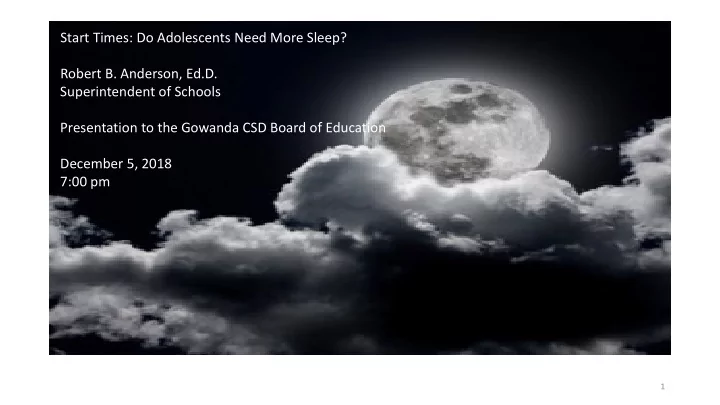

Start Times: Do Adolescents Need More Sleep? Robert B. Anderson, Ed.D. Superintendent of Schools Presentation to the Gowanda CSD Board of Education December 5, 2018 7:00 pm 1
Questions to Contemplate • Is the proposal “evidence-based?” • Is the proposal in the best interest of our students? Work Cited: (Maro, 2016) 2
Adolescents & Sleep • During puberty, around age 13, circadian rhythms put most teens on a later-sleep-wake clock due to biological changes involving melatonin in the brain. • Stronger phase shift until peaking between 17-19. • Clock says time to go to school, body says its is still the middle of the night. 3
On school nights, teens typically get less than 7 hours of sleep, yet need approximately 9 hours. 4
5
Of course, in addition to biological factors, lifestyle choices, environment and academic demands, negatively affect middle and high school students from obtaining adequate sleep. 6
National Sleep Foundation stated “sleep deprived teens are unable to maximize the learning opportunities afforded by the education system, since sleep deprivation impairs their ability to pay attention, solve problems, cope with stress, and retain information.” 7
What else? Adolescents who do not get enough (insufficient): sleep • More likely to be overweight; • Not engage in daily physical activity; • Suffer from depressive symptoms; • Engage in unhealthy risky behaviors; and/or, • Perform poorly in school. 8
Evidence strongly implicates earlier start time (earlier than 8:30 am) as a key modifiable contributor to insufficient sleep. GHS: 7:32 am GMS: 7:15 am Work Cited: American of Pediatrics, 2018 9
Evidence suggests that … 1. delaying start times is an effective counter measure to chronic sleep loss as well as benefitting physical/mental health, safety and academic achievement. 2. later start times have an impact on standardized scores, especially lower performing students. Work Cited: American of Pediatrics, 2018 10
other positives 11
• There are several advantages for teens to get the sleep they need: 1. less likelihood of experiencing depressed moods; 2. reduced likelihood for tardiness; 3. reduced absenteeism; 4. better grades; 5. reduced risk of drowsy driving; and 6. reduced risk of metabolic and nutritional deficits associated with insufficient sleep, including obesity. Work Cited: American of Pediatrics, 2018 12
Recommendations American Academy of Pediatrics: MS/HS start at 8:30 am or later. 13
Recommendations American Academy of Sleep: students aged 13-18 regularly need 8-10 hours of sleep. 14
15
Possible Barriers & Issues to Address • Contractual issues • Sports/after school activities: late start/late return • Vocational; Out of District Programming • After school care by older siblings • Reverser impact on younger children • Public sentiment • Change 16
Possible examples, but certainly not only possibilities… • Single start time w/ one bus schedule ($) • Flip current start times • Move all start times later 17
18
Recommended Action: • Create Steering Committee, with stakeholders, to Investigate Issue Further and Make Specific Recommendations to BOE • Specifics to Follow • Earliest Targeted Implementation: 2020-21 School Year 19
Works Cited • American Academy of Pediatrics. (2018). Policy Statement: School Start Times for Adolescents. • Edwards, F. (Summer,2015). Do schools begin too early? Educationnext.org. Retrieved from http: • Fischetti, M. (2014, September). School starts too early. Scientificamerican.com. Retrieved from http://www.scientificamerican.com/article/school-starts-too-early/ • Paruthi, S., et al., (2016). Recommended Amount of Sleep for Pediatric Populations: A Consensus Statement of the American Academy of Sleep. Journal of Clinical Sleep 12(6), 785-786. • Mauro, B. (2016, July). Changing High School Start Times: Science Paves the Way. On Board Online. Retrieved from http://www.nyssba.org/news/2016/07/21/on-borad-online-july-25- 2016/changing-high-school-start-times-science-paves-the-way/ • Wahlstrom, K.L. (2014). Examining the Impact of later High School Start Times on the Health and Academic Performance of High School Students: A Multi-Site Study. Center for Applied Research and Educational Improvement. University of Minnesota, 2014. • Wheaton, A., G. Ferro, J. Croft. (2015). School Start times for Middle School and High School Students-United States, 2011-12 school year. Centers for Disease Control: Morbidity and Mortality Weekly Report , 64(30), 809-813. 20
Recommend
More recommend